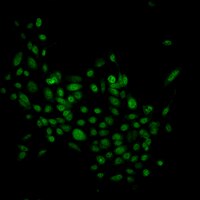SCC627 Sigma-AldrichmEERL Mouse E6/E7/hRas Oropharynx Epithelial Luciferase Cell Line
The SCC627 mEERL Mouse E6/E7/hRas Oropharynx Epithelial Luciferase Cell Line expresses luciferase and is useful in the study of head and neck squamous cell carcinoma in an immunocompetent, syngeneic m
More>> The SCC627 mEERL Mouse E6/E7/hRas Oropharynx Epithelial Luciferase Cell Line expresses luciferase and is useful in the study of head and neck squamous cell carcinoma in an immunocompetent, syngeneic model. Less<<Recommended Products
Overview
| Product Information | |
|---|---|
| Components |
|
| Quality Level | MQ100 |
| Biological Information | |
|---|---|
| Host | Mouse |
| Cell Line Type |
|
| Product Usage Statements | |
|---|---|
| Quality Assurance | mEERL cells are verified to be of mouse origin and negative for human, rat, Chinese hamster, Golden Syrian hamster, and non-human primate interspecies contamination, as assessed by a Contamination Clear panel by Charles River Animal Diagnostic Services Cells tested negative for infectious diseases against a Mouse Essential CLEAR panel by Charles River Animal Diagnostic Services. Cells tested negative for mycoplasma. |
| Usage Statement |
|
| Packaging Information | |
|---|---|
| Material Size | >= 1 x 10^6 viable cells per vial |
| Global Trade Item Number | |
|---|---|
| Catalog Number | GTIN |
| SCC627 | 04065270977410 |













